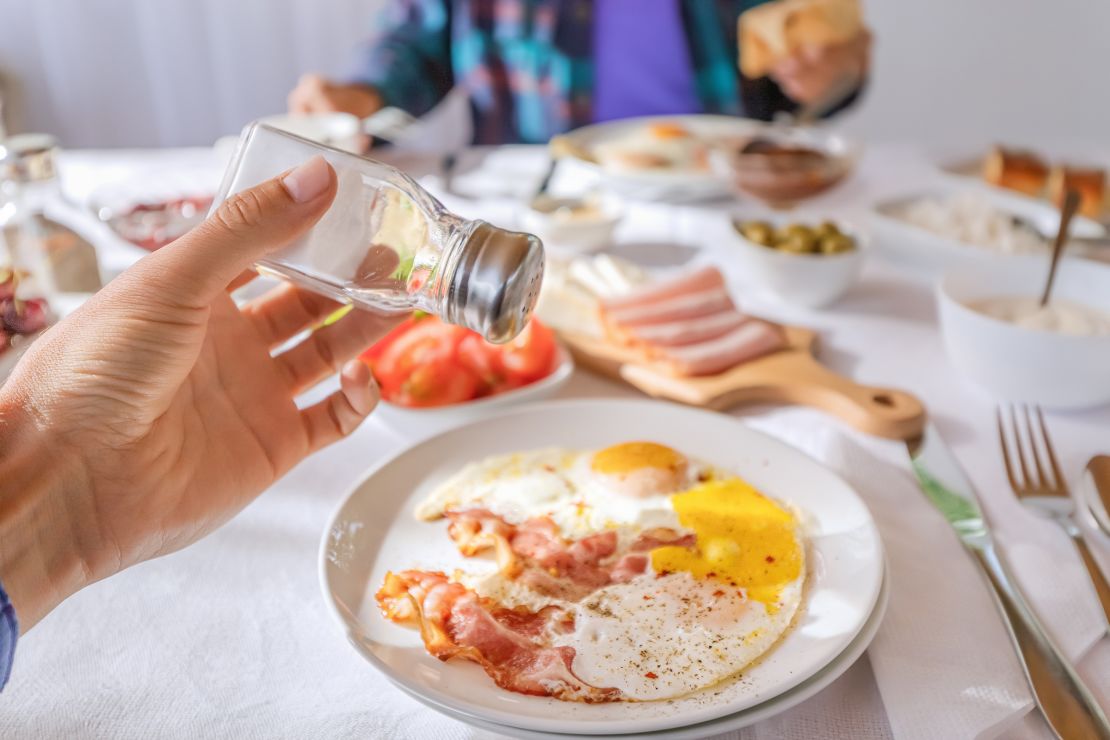Sign up for CNN’s Eat, But Better: Mediterranean Style. Our eight-part guide shows you a delicious expert-backed eating lifestyle that will boost your health for life.
Using less salt in your food may seem boring, but the payoffs could be as big as a lowered risk of death, new research has found.
Using a salt substitute when cooking was linked with a lower risk of dying early from any cause or from cardiovascular disease in a new study published Monday in the journal Annals of Internal Medicine.
“We are excited to be able to provide evidence that salt substitutions are effective for improving cardiovascular outcomes when used long-term, up to 10 years,” said the study’s senior author Dr. Loai Albarqouni, an assistant professor at the Institute for Evidence-Based Healthcare at Bond University in Australia. “Previous synthesis tended to focus on short-term outcomes, lasting only two weeks.”

The study is a systematic review of 16 randomized controlled trials that were published before August 23, 2023, and totaled 35,251 participants who were around age 64 on average and had a higher-than-average risk for cardiovascular disease. The trials were mainly in China, with the rest in the United Kingdom, Taiwan, Peru, the Netherlands and Norway.
With two-thirds of the findings coming from China, the authors “were surprised at how little salt substitution research has been conducted outside Asian countries,” Albarqouni said. “This is partially why we have graded the evidence as ‘low to very low certainty’ for Western populations — there simply isn’t enough evidence to verify that salt substitutes would be as effective in the Western context.”
Salt substitution was also linked with a reduction in sodium in urine, and in blood pressure, an effect similar to that of blood pressure medications, the authors found. That could explain the lowered risk of death, Albarqouni said.
The authors acknowledged that in the trials, some of the salt substitutes were not verified and some were purchased by the participants instead of given to them by researchers.
The trials compared the use of common salt — made of about 100% sodium chloride, occasionally with added iodine — with using a salt substitute comprised of 25% to 30% potassium chloride and 60% to 75% sodium chloride.
Another reason why applying the findings to a Western context is difficult is that salt consumption patterns in North America are “driven by processed and takeaway food, while consumption in the research context is more driven by the high amount of salt added during home food preparation,” Albarqouni said.
“This is not the strongest study to base a lot of conclusions on at this point,” said Dr. Andrew Freeman, a preventative cardiologist and director of cardiovascular prevention and wellness at National Jewish Health in Denver. “But it adds to the body of evidence and the signal in the noise that getting rid of sodium salt in your diet is a big plus and getting potassium in your diet is better,”
And “while we know potassium is beneficial, salt is salt,” Freeman, who wasn’t involved in the study, added. “If it’s sodium chloride or potassium chloride or magnesium chloride, it’s all salt. And the best way to get potassium in your body is to eat fruits and vegetables — that’s where potassium is most plentiful.”
Lowering your salt intake
The American Heart Association’s ideal daily sodium limit is 1,500 milligrams per day for most adults, especially those with high blood pressure, and no more than 2,300 milligrams daily.
“If the majority of your food intake is coming from packaged or restaurant food, chances are your sodium intake is too high,” Albarqouni said via email. “There are a few physical signs you may be eating too much sodium, like bloating or swelling, tiredness, high blood pressure, increased thirst and/or urination.”
If you’re concerned about your intake, you can seek medical or nutrition advice from a professional, Albarqouni added.
When buying packaged food, check the sodium content on labels. Some foods can contain more sodium than you think, such as poultry or cereals, Freeman said. One standard-size pickle typically has around 1,500 milligrams of salt, he added.
Besides lowering salt consumption by simply eliminating salt in your home cooking, you can also try purchasing salt substitutes with a composition like the ones used in the study or using salt-free seasonings to add more flavor to food instead, experts said.
The authors acknowledged that more research is needed to confirm whether salt substitution of the study’s kind is safe for patients “sensitive to micronutrient manipulation,” including those sensitive to potassium — such as people with renal deficiency, they said.
Food with less salt may taste boring at first, but your tastebuds can adjust within just a couple of weeks, Freeman said, so give yourself time to adjust.
“It’s also important to remember that reducing sodium intake is just one way to reduce cardiovascular risk without medication,” Albarqouni said. “Things like diet changes, stopping smoking and increasing movement can also have an impact. Salt substitutes are not a holy grail to eliminating cardiovascular disease, but are one piece of the puzzle that can help.”







